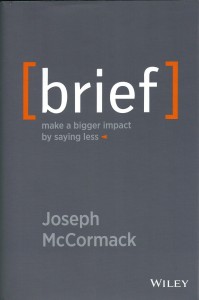The one-sentence summary
You can make a bigger impact by saying less – map it, tell it, talk it, and show it.
Can’t be bothered to read it? Listen to the 5-minute summary.
WHAT THE BOOK SAYS 
- This book is all about making a bigger impact by saying less.
- Most day-to-day communications are unfocused and unclear. In a world where everyone is inundated with too much information and highly inattentive, being brief isn’t a nicety, it’s a necessity.
- People who struggle with brevity suffer variously from cowardice, (over) confidence, callousness, comfort, confusion, complication, and carelessness.
- Audiences that are mind-filled rather than mindful suffer from inundation, inattention, interruption and impatience.
- There are four things you need to do to communicate effectively and efficiently:
1. Map it – map out the argument, then condense and trim volumes of information from it.
2. Tell it – use narrative storytelling to explain the message in a clear, concise and compelling way.
3. Talk it – the TALC system turns monologues in meetings into controlled, productive conversations: Talk, Actively Listen, Converse.
4. Show it – use visuals to attract attention and capture the imagination.
WHAT’S GOOD ABOUT IT
- The Elusive 600: people speak about 150 words per minute, yet have the mental capacity to consume 5 times that number – 750. So the Elusive 600 is the other stuff they are distracted by when you are speaking to them. It’s your job to stop their attention leaking.
- Brevity is not just about time. It doesn’t just mean being concise.
- Light brevity is being concise without comprehension.
- Deep brevity is being succinct with savvy. Aim for the latter.
- All presentations should be subject to trimming.
~ Level 1 details are absolutely essential.
~ Level 2 details add a little flavour but shouldn’t take up too much time.
~ Level 3 items weigh the story down and don’t make it noticeably better.
- Bottom line upfront is the best way to start any presentation: your message is immediately clear, and remains so even if the meeting is cut short or someone has to leave early.
- WIFM stands for What’s In It For Me? All presenters should consider this question in relation to the person(s) they are presenting to. Know what motivates your audience, skip what doesn’t matter, and make a conclusive delivery.
- Flagging is calling out the number of ideas you want to share. This provides an order to any presentation, and keeps the audience connected, waiting for you to deliver that number of points.
- TLDR stands for Too Long, Didn’t Read and TLDW stands for Too Long, Didn’t Watch. Make sure your material doesn’t fall into these categories.
WHAT YOU HAVE TO WATCH
- Not much. The sentiment matches precisely that of my own book Tick Achieve.
